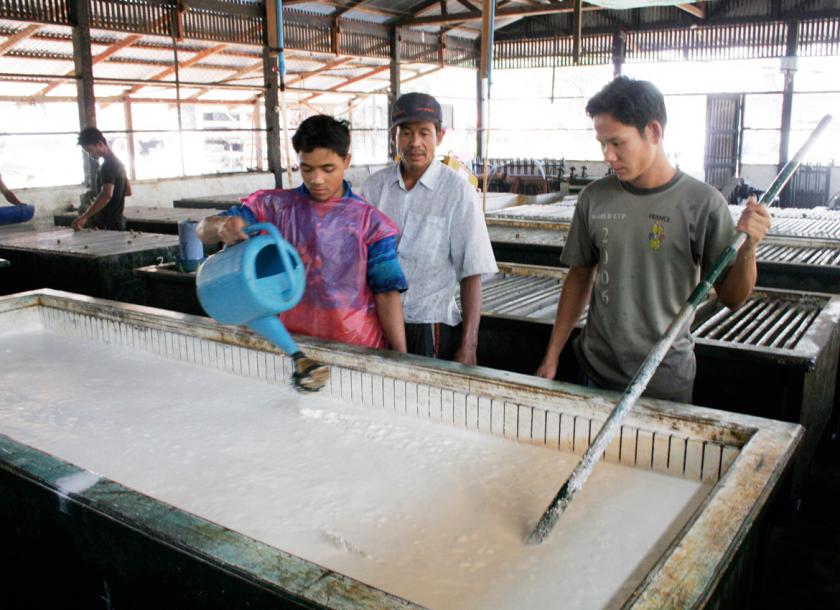Although the price of rubber has fallen in the global market, international demand for rubber produced in Myanmar is on the rise
15 พฤศจิกายน 2560
The price of rubber has fallen below its cost of production in major exporting countries. Yet, international demand for rubber produced in Myanmar has risen and insiders reckon things could remain upbeat for a while more.
“Myanmar rubber production will certainly increase on the back of rising international consumption and demand,” U Myo Thant, vice-chair at the Myanmar Rubber Planters and Producers Association (MRPPA), told The Myanmar Times.
The emerging trend represents a rare opportunity for Myanmar rubber producers to secure a foothold in the global market after lagging for years behind the world’s three major rubber producing countries: neighbouring Thailand as well as Malaysia and Indonesia.
Cyclical trade
The global rubber trade is an inherently cyclical one. Rubber tree saplings take 7-10 years to mature before the barks are removed to harvest natural rubber, a sticky, cream-like sap which is used to produce tyres and other goods.
The rubber produced is then processed and graded for quality. RSS3 rubber, for instance, is used as a component in tyre-making, while RSS5 is of cheaper and lower-grade quality. According to U Myo Thant, major rubber producers will soon be unable to supply sufficient quantities of rubber to tyre factories in China and other importing countries because rubber saplings have not reached the right age for harvesting.
Meanwhile, the International Tripartite Rubber Council (ITRC) comprising Thailand, Malaysia and Indonesia announced this month that it expects the ‘La Nina’ weather phenomenon to bring heavy rains to the region in the coming months which will affect production and supply of natural rubber to global markets.
The ITRC also concluded that current prices of rubber were “not reflective of market fundamentals.” Prices of Thai natural rubber have fallen from a peak of 179.25 baht ($5.41) per kg in 2011 to 47.75 baht on November 10, according to Reuters.
This is where Myanmar can step up to fill the gap and establish itself as a serious rubber exporter, U Myo Thant said. Currently, there are some 1.6 million acres of rubber plantation land in Myanmar, with 7 million trees now at the right age for harvesting natural rubber. Most of the country’s rubber trees are grown in Mon State as well as in the Taninthayi and Bago regions.
Quality issues
Demand already appears to be rising, with more than 700 tonnes exported to China and Thailand via Myanmar’s order gates in the second week of October compared to 460 tonnes in the first week of that month, according to government data. In September, Myanmar exported a total of 1,077 tonnes of rubber.
Around 80 percent of the rubber produced is exported to China with the remaining sold to Thailand, Malaysia and Japan as well as local factories.
Yet, rubber prices in Myanmar lag behind global spot prices when rising, but fall just as fast,” said U Mehn Htein Win, coordinator for the Mon State Development Advisory Group. For example, Myanmar rubber prices are currently K835-K840 per pound, while the Thai equivalent is K873 per pound.
This is due to inconsistent grades of rubber produced by local plantations. “Around 85pc of Myanmar rubber plantations is run by small-scale rubber farmers which causes the product form and quality to differ from each other. Myanmar rubber production is not standardised. We can’t guarantee consistency across one product form,” he said.
U Tun Htay , Mon State Minister for Agriculture, Livestock, Transportation and Communications told local media that 90pc of Myanmar rubber is low-quality, resulting in industry losses of K400 million a year. Because of the lack of quality and demand for Myanmar-produced rubber, producers are at a disadvantage and forced into becoming price takers of sell their products.
The other reason for poor quality is the lack of skilled manpower. “Our region is near Thailand, so most of our skilled workers go to Thailand to earn money,” U Aung Myo, chair of Dawei District Rubber Growers Association, told The Myanmar Times.
Chinese demand
The other problem is illegal exports. “Actually, 50pc of the exports to China are illegal. China buys every form of rubber type, including the cheap Khot Tone, Khot Hmout , Ahtu Pya rubber. They state the price they want for the low-grade rubber and transport the rubber to their factories for tyre production and value-add,” said U Mehn Htein Win.
He added that seven of the nine foreign robber factories in Mudon, Mon State, are also Chinese rubber factories.
But things could change for the better from now on. Besides China, Japan has also expressed interest in buying Myanmar rubber by cooperating with the MRPPA. The government is also supporting rubber as a national strategic crop, said U Win Thu, director from Myanmar Trade Promotion from the Ministry of Commerce. It is now also building a rubber laboratory in Yangon to raise the quality of local rubber.
Meanwhile, a K2 billion factory producing high-quality rubber near Thabya Village in Dawei township in Thaninthayi region is expected to begin operations in December. Plans to build two more factories are underway, The Myanmar Times understands.
Next year, Norway’s Nyor Company, together with Thai Southland Company and the Karen State Rubber Production Association, also intend to build a rubber refinery in Hpa-An Industrial Zone. Foreign participation in the project is expected to raise the quality of and add value to locally-produced rubber. This will raise international demand and reduce illegal exports.
On the whole, most producers are also expecting the rubber market to develop further and become more open.
(The Myanmar Times: https://www.mmtimes.com/news/myanmar-rubber-exports-set-rise-even-global-prices-take-beating.html )











